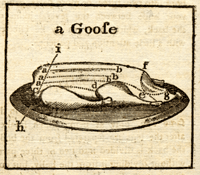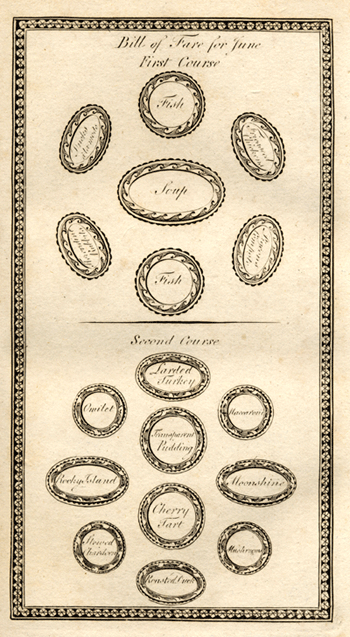
Allison Meyer
Food ties in with many themes found in Thomas Jefferson’s life. Jefferson loved to entertain, and indeed often used the small dinner party as a political tool.[1] He was a farmer and a scientist. Always interested in the garden, he experimented with 250 varieties of at least 70 species of vegetables.[2] Jefferson was involved with food in many ways before he enjoyed it once it was presented at table.
 |
| From The Honours of the Table |
Jefferson’s cuisine reflected his many travels and his appreciation of fine quality and excellence in the arts. The composite nature of his table was a cause for comment, both good and bad, by his contemporaries. To Patrick Henry, Jefferson had become “so Frenchified that he abjured his native victuals.”[3] Daniel Webster commented that dinner at Monticello was “in half Virginian, half French style, in good taste and abundance.”[4]
Jefferson took care to have a good cook in the kitchen, and was willing to pay what it cost to retain one. Shortly before his inauguration as president, he wrote, “I understand that twenty dollars a month is what is given to the best French cook, however, the Chevalier d’Yrugo having been so kind as to undertake to get the one which he deemed the best in Philadelphia, I authorized him to go as high as twenty-eight dollars.”[5] When he was in Annapolis, he arranged for a French chef to train one of his slaves, and he had James Hemings accompany him on his diplomatic appointment to France in order to learn French cooking. Later, when Jefferson freed Hemings, it was under the condition that another Monticello slave be trained “in the art of cookery.”[6]
As well as having skilled cooks, Jefferson made sure that the best ingredients possible were available for his cooks. He imported olive oil and wine, purportedly while he was in Italy he sent Parmesan cheese back to Virginia, and requested a correspondent in France to send him vanilla beans.[7] Other items Jefferson cultivated in his garden. Among his 70 varieties of vegetables were squash and broccoli from Italy, figs from France, and peppers from Mexico.[8] Jefferson tracked the progress of his garden, noting when seeds germinated, plants flowered, and when crops came to table.
Reading his entries in the Garden Book reminds the modern reader that the food on the table primarily reflected what was growing in the garden, or what had been successfully preserved through drying or pickling. For greater variety through the year, Jefferson would sow seed of various vegetables several times through the season. For example, in 1811 he sowed winter spinach four times (although Jefferson notes that the last sowing was too late), and five different varieties of lettuce in a total of 19 plantings.[9] Those fruits and vegetables that could be preserved through pickling, candying, or drying retained the characteristic aspects of their method of preservation when they made it to the table out of season.
Jefferson would go down to the market while he was present and note the earliest and latest appearance at market of 37 vegetables for the eight years he was present.[10] Jefferson was also involved directly with some of the market-gardeners in Washington. Receiving seeds sent to him from all over the world, Jefferson gave these to the market-gardeners, “not sending them, but giving himself and accompanying his gifts with the information necessary for their proper culture and management, and afterwards occasionally calling to watch the progress of their growth.”[11] He further fostered their activities by having his steward pay the highest prices for “the earliest and best products of these gardens.”[12]
Jefferson was as fond of vegetables at the table as in the garden. He described his own eating habits in a letter to Dr Vine Utley with these words: “I have lived temperately, eating little animal food, and that not as an aliment, so much as a condiment for the vegetables, which constitute my principle diet.”[13] His grandchildren wrote similar recollections of Jefferson’s eating habits.[14] The Monticello overseer, Edmund Bacon recalled:
He never eat much hog meat. He often told me, as I was giving out meat for the servants, that what I gave one of them for a week would be more than he would use in six months.… He was especially fond of Guinea fowls; and for meat he preferred good beef, mutton, and lambs.… He was very fond of vegetables and fruit and raised every variety of them.[15]
Yet, though Jefferson himself did not eat much meat, his visitors recount a table set plentifully with meat and vegetable alike. Dinner began in the mid to late afternoon and was the principle meal of the day. No dinner menu survives from Monticello, however fragments of travelers’ accounts talk about the meals they shared with Thomas Jefferson. The household accounts of Martha Wayles Skelton Jefferson and Martha Jefferson Randolph that survive describe the regulation of the Monticello kitchen: a loaf of sugar broke, a barrel of flour opened, a beef killed, eggs purchased from one of the slaves.[16] The description of a dinner served while Jefferson was president compared with bills of fare in contemporary cookbooks shows that his table was set in a manner that we would expect from a gentleman of his station. The visitor wrote:
Dinner not as elegant as when we dined before. Rice soup, round of beef, turkey, mutton, ham, loin of veal, cutlets of mutton or veal, fried eggs, fried beef, a pie called macaroni.… Ice cream very good…; a dish somewhat like pudding… covered with cream sauce—very fine. Many other jimcracks [nuts, sweetmeats, and fruit], a great variety of fruit, plenty of wines, and good.[17]
Period cookbooks provide us with a guide for understanding period combinations of foods, as well as the number of dishes and their layout upon the table. In many works the sample bills of fare for dinner contained two courses, followed by a dessert course, then fruit and nuts. The 1805 edition of Hannah Glasse’s The Art of Cookery made Plain and Easy includes three courses in each bill of fare, as well as the dessert followed by fruit and nuts. This method of presenting food in overwhelming abundance, with many items to choose from for each course, was a tradition that began in medieval England and carried through until the 19th century. Guests understood that they were free to choose those items that they found most appealing, not unlike a modern buffet.[18]
 |
| John Farley's Bill of Fare for June |
The dishes of each course were laid out in a symmetrical pattern upon the table. Some bills of fare call for a “remove,” a convention in which a dish is served to the company, then taken from the table to make space for an additional dish placed in that location on the table.[19] The customary number of dishes depended upon the size of the gathering, but was generally an odd number for each course.
Martha Bradley, author of The British Housewife, lamented the English tradition of square or rectangular tables for their limit in the number of ways one could lay out the dishes, preferring the French practice of using a round or oval shaped table. Reflecting the period’s preference for curvilinear forms she writes: “A great Painter has lately wrote to prove that there cannot be Beauty in strait Lines: The Tables we use are composed of such, and the Example was never more fully illustrated.”[20]
Just as clothing fashions from time to time recall a previous epoch, so too the fashions of the table. In Festive Traditions a letter from a lady describes an entertainment in Philadelphia held by the Binghams in 1798, at which the dining table featured an orange tree in the center, and dishes arranged to adorn the rest of the table.[21] In Pleasures of the Table we find a reproduction of Jean Berain’s drawing of a collation table at Chantilly which features an orange tree in the center and baskets of fruit arranged in the form of a parterre, and dates from 1688, approximately 100 years before the entertainment in Philadelphia.[22]
For a better idea of the foods and manner of serving them that comprised a gentile dinner in the latter half of the 18th century, refer to the interactive bill of fare . For a better idea of where these foods were stored in the plantation household, refer to the interactive map of food storage.
[1] Mrs Samuel Harrison (Margaret Bayard) Smith noted in a letter, incorporated into The First Forty Years of Washington Society, that “when he [Jefferson] had any persons dining with him, with whom he wished to enjoy a free and unrestricted flow of conversation, the number of persons at table never exceed four.…” (p.387) She knew Jefferson when he was president and went to visit him at Monticello after his retirement.
[2] Monticello website at: http://www.monticello.org/jefferson/vegetable/home.html
[3] Patrick Henry, as quoted by Helen D. Bullock in Marie Kimball’s Thomas Jefferson’s Cook Book, p.1.
[4] Daniel Webster, as quoted by Marie Kimball in Thomas Jefferson’s Cook Book, p.23.
[5] TJ, as quoted by Marie Kimball in Thomas Jefferson’s Cook Book, p.20.
[6] Monticello website at: http://www.monticello.org/jefferson/dining/profile.html
[7] Evan Jones in American Food,
p.39. (Jones provides no documentation about the cheese.)
TJ in a letter to William Short, American chargé in Paris, 1791, as printed
in Marie Kimball’s Thomas Jefferson’s Cook Book, p.13.
[8] Monticello website at: http://www.monticello.org/jefferson/vegetable/home.html
[9] TJ in Thomas Jefferson’s Garden Book, Edwin Morris Betts, Ed., p.442-444.
[10] The chart is entitled “A Statement of the Vegetable market of Washington, during a period of 8. years, wherein the earliest & latest appearance of each article within the whole 8. years is noted.” and printed as part of Appendix III of Thomas Jefferson’s Garden Book, annotated by Edwin Morris Betts, p.639.
[11] Mrs Samuel Harrison (Margaret Bayard) Smith, The First Forty Years of Washington Society, p.394.
[12] Mrs Samuel Harrison (Margaret Bayard) Smith, The First Forty Years of Washington Society, p.394.
[13] TJ in letter to Dr Vine Utley, Monticello, March 21, 1819. Printed in Thomas Jefferson Writings, edited by Merrill D. Peterson, p.1416.
[14] Monticello website at: http://www.monticello.org/resources/life/vegetarian.html
[15] Edmund Bacon, as quoted by the Monticello website at: http://www.monticello.org/resources/life/vegetarian.html
[16] Martha Jefferson in Household Accounts, 1772-1782, manuscript in Cases Tried in Virginia Courts, 1768-9. Jefferson Papers, Series 7, Vol.1.
[17] This version of the quote taken from the Monticello website at: http://www.monticello.org/jefferson/dining/home.html, also quoted in slightly different form in Marie Kimball’s Thomas Jefferson’s Cook Book, p.16.
[18] Ivan Day, ed., Eat, Drink & Be Merry: The British at Table 1600–2000, p.49.
[19] C.Anne Wilson, “Ideal Meals and their Menus from the Middle Ages to the Georgian Era,” in The Appetite and the Eye, p.111.
[20] Martha Bradley, The British Housewife, p.70.
[21] Louise Conway Belden, Festive Traditions, p.4.
[22] Peter B. Brown and Ivan Day, Pleasures of the Table: Ritual and Display in the European Dining Room 1600–1900, p.15.